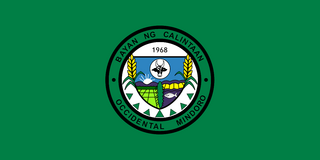
Puerto Galera, officially the Municipality of Puerto Galera, is a 1st class municipality in the province of Oriental Mindoro, Philippines. According to the 2020 census, it has a population of 41,961 people.

Ilog, officially the Municipality of Ilog, is a 2nd class municipality in the province of Negros Occidental, Philippines. According to the 2020 census, it has a population of 59,855 people.

San Jose, officially the Municipality of San Jose, is a 1st class municipality in the province of Occidental Mindoro, Philippines. According to the 2020 census, it has a population of 153,267, representing a third of the provincial population, and is the largest among cities and municipalities in the Mimaropa region.

Gloria, officially the Municipality of Gloria, is a 3rd class municipality in the province of Oriental Mindoro, Philippines. According to the 2020 census, it has a population of 50,496 people.

Binalbagan, officially the Municipality of Binalbagan, is a 1st class municipality in the province of Negros Occidental, Philippines. According to the 2020 census, it has a population of 71,407 people.

Calintaan, officially the Municipality of Calintaan, is a 3rd class municipality in the province of Occidental Mindoro, Philippines. According to the 2020 census, it has a population of 30,190 people.

Looc, officially the Municipality of Looc, is a 5th class municipality in the province of Occidental Mindoro, Philippines. According to the 2020 census, it has a population of 7,802 people.

Lubang, officially the Municipality of Lubang, is a 4th class municipality in the province of Occidental Mindoro, Philippines. According to the 2020 census, it has a population of 17,437 people.

Magsaysay, officially the Municipality of Magsaysay, is a 3rd class municipality in the province of Occidental Mindoro, Philippines. According to the 2020 census, it has a population of 39,767 people.

Mamburao, officially the Municipality of Mamburao, is a 2nd class municipality and capital of the province of Occidental Mindoro, Philippines. According to the 2020 census, it has a population of 47,705 people.

Paluan, officially the Municipality of Paluan, is a 3rd class municipality in the province of Occidental Mindoro, Philippines. According to the 2020 census, it has a population of 18,566 people.

Rizal, officially the Municipality of Rizal, is a 3rd class municipality in the province of Occidental Mindoro, Philippines. According to the 2020 census, it has a population of 40,429 people.

Sablayan, officially the Municipality of Sablayan, is a 1st class municipality in the province of Occidental Mindoro, Philippines. According to the 2020 census, it has a population of 92,598 people.

Santa Cruz, officially the Municipality of Santa Cruz, is a 1st class municipality in the province of Occidental Mindoro, Philippines. According to the 2020 census, it has a population of 42,417 people.

Pola, officially the Municipality of Pola, is a 3rd class municipality in the province of Oriental Mindoro, Philippines. According to the 2020 census, it has a population of 35,455 people. It is 74 kilometres (46 mi) from Calapan.

Baco, officially the Municipality of Baco, is a 3rd class municipality in the province of Oriental Mindoro, Philippines. According to the 2020 census, it has a population of 69,817 people.

Bansud, officially the Municipality of Bansud, is a 2nd class municipality in the province of Oriental Mindoro, Philippines. According to the 2020 census, it has a population of 42,671 people.

Bongabong, officially the Municipality of Bongabong, is a 1st class municipality in the province of Oriental Mindoro, Philippines. According to the 2020 census, it has a population of 76,973 people.

Bulalacao, officially the Municipality of Bulalacao, is a 3rd class municipality in the province of Oriental Mindoro, Philippines. According to the 2020 census, it has a population of 44,366 people.

Naujan, officially the Municipality of Naujan, is a 1st class municipality in the province of Oriental Mindoro, Philippines. According to the 2020 census, it has a population of 109,587 people.

























